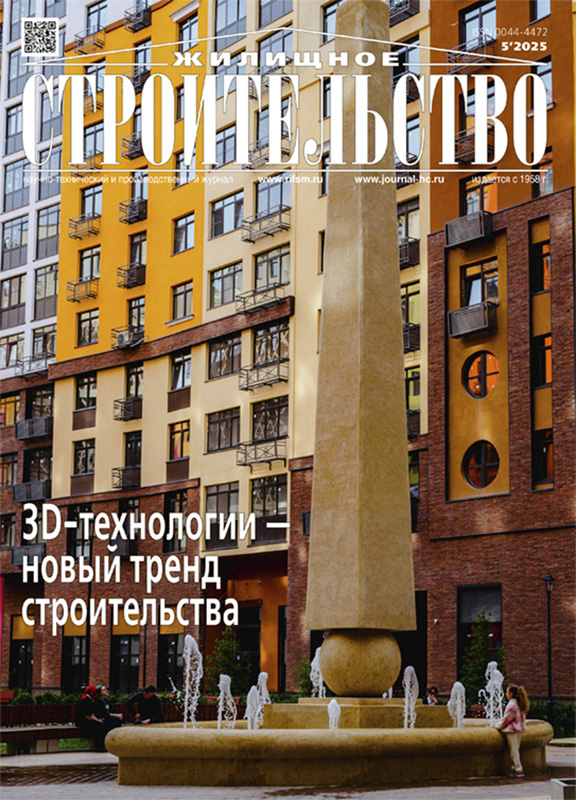Исследование энергоэффективности систем фасадных теплоизоляционных композитных с разными видами теплоизоляции в резко-континентальном климате
- Авторы: Бегич Я.Э.1, Павленко Н.В.2,3, Набережный А.Д.4, Турантаев Е.Е.4,5, Кушнир С.В.6
-
Учреждения:
- Санкт-Петербургский политехнический университет Петра Великого
- Научно-исследовательский институт строительной физики Российской академии архитектуры и строительных наук
- Научно-исследовательский институт механики Московского государственного университета им. М.В. Ломоносова
- Институт мерзлотоведения им. П.И. Мельникова Сибирского отделения Российской академии наук
- Северо-Восточный федеральный университет им. М.К. Аммосова
- Центральный научно-исследовательский институт строительных конструкций им. В. А. Кучеренко
- Выпуск: № 5 (2025)
- Страницы: 58-65
- Раздел: СТАТЬИ
- URL: https://snv63.ru/0044-4472/article/view/684362
- DOI: https://doi.org/10.31659/0044-4472-2025-5-58-65
- ID: 684362
Цитировать
Аннотация
Проанализированы существующие методики по вопросам оптимизации проектных решений по утеплению здания, а также существующие нормативные требования по подбору ограждающих конструкций. Предложена методика для проведения эксперимента по определению наиболее выгодных характеристик теплоизоляционного материала в условиях г. Якутска. В рамках исследования были возведены постройки с различными видами теплоизоляции для штукатурных фасадных конструкций. Необходимая толщина конструкции определялась в соответствии с текущими нормативными требованиями. В помещениях поддерживалась постоянная температура и влажность. С помощью счетчиков в экспериментальных постройках производились ежедневные измерения потребления ресурсов на отопление помещения. Приведены результаты измерений теплотехнических показателей и затрат на отопление в каждом из объектов. Произведено сравнение эффективности и затрат на отопление при использовании различных теплоизоляционных материалов в ограждающей конструкции. Сделан вывод об эффективности материалов конструкций в условиях крайнего севера.
Полный текст
Об авторах
Я. Э. Бегич
Санкт-Петербургский политехнический университет Петра Великого
Автор, ответственный за переписку.
Email: yasmin1010@yandex.ru
инженер
Россия, ул. Политехническая, 29, Санкт-Петербург, 195251Н. В. Павленко
Научно-исследовательский институт строительной физики Российской академии архитектуры и строительных наук; Научно-исследовательский институт механики Московского государственного университета им. М.В. Ломоносова
Email: nv-pavlenko@mail.ru
канд. техн. наук, доцент
Россия, Локомотивный пр., 21, Москва, 127238; Мичуринский пр., 1, Москва, 119192А. Д. Набережный
Институт мерзлотоведения им. П.И. Мельникова Сибирского отделения Российской академии наук
Email: artemon2003@inbox.ru
канд. техн. наук, зав. лабораторией инженерной геокриологии
Россия, ул. Мерзлотная, 36, Якутск, 677010Е. Е. Турантаев
Институт мерзлотоведения им. П.И. Мельникова Сибирского отделения Российской академии наук; Северо-Восточный федеральный университет им. М.К. Аммосова
Email: egtur98@gmail.com
инженер
Россия, ул. Мерзлотная, 36, Якутск, 677010; ул. Белинского, 58, Якутск, 677027С. В. Кушнир
Центральный научно-исследовательский институт строительных конструкций им. В. А. Кучеренко
Email: 17478772@mail.ru
зав. сектором облицовочных изделий и материалов лаборатории надежности фасадов и теплоизоляционных фасадных систем
Россия, ул. 2-я Институтская, 6, Москва, 109428Список литературы
- Lesovik V.S., Puchka O.V., Vaisera S.S. Reduction of energy consumption of thermal insulation materials // International Journal of Applied Engineering Research. 2015. Vol. 10. No. 19, pp. 40599–40602. EDN: VAJSLZ
- Грабовый К.П., Киселева Е.А. Энергоэффективность жилищного фонда как экономический стимул повышения потребительских качеств объектов недвижимости // Вестник МГСУ. 2015. № 3. С. 79–91. EDN: TMEUYF
- Friess W.A., Rakhshan K. A review of passive envelope measures for improved building energy efficiency in the UAE // Renewable and Sustainable Energy Reviews. 2017. Vol. 72, pp. 485–496.
- Жуков А.Д., Боброва Е.Ю., Бессонов И.В. Строительные системы и особенности применения теплоизоляционных материалов // Жилищное строительство. 2015. № 7. С. 49–51. EDN: VCMAAJ
- Леонова А.Н., Курочка М.В. Методы повышения энергоэффективности зданий при реконструкции // Вестник МГСУ. 2018. Т. 13. № 7 (118). С. 805–813. EDN: XUWKPB. https://doi.org/10.22227/1997-0935.2018.7.805-813
- Kuczyński T., Staszczuk A. Experimental study of the influence of thermal mass on thermal comfort and cooling energy demand in residential buildings // Energy. 2020. Vol. 195. 116984. EDN: FZDVSC. https://doi.org/10.1016/j.energy.2020.116984
- Alayed E. et al. Thermal mass impact on energy consumption for buildings in hot climates: A novel finite element modelling study comparing building constructions for arid climates in Saudi Arabia // Energy and Buildings. 2022. Vol. 271. 112324. EDN: OOWPRJ. https://doi.org/10.1016/j.enbuild.2022.112324
- Алоян Р.М., Федосеев В.Н., Виноградова Н.В., Зайцева И.А. Возможности и проблемы энерго-эффективных и энергосберегающих технологий в строительстве и текстильной промышленности // Известия высших учебных заведений. Технология текстильной промышленности. 2017. № 5 (371). С. 196–198. EDN: YUPWCZ
- Чеботарев Д.А. К вопросу об эффективности энергосбережения // Academia. Архитектура и строительство. 2010. № 3. С. 419–422. EDN: NTLCEF
- Умнякова Н.П., Бутовский И.Н., Чеботарев А.Г. Развитие методов нормирования теплозащиты энергоэффективных зданий // Жилищное строительство. 2014. № 7. С. 19–23. EDN: SHORXP
- Крышов С.И., Курилюк И.С. Проблемы экспертной оценки тепловой защиты зданий // Жилищное строительство. 2016. № 7. С. 3–5. EDN: WHFUSH
- Перехоженцев А.Г. Нормирование сопротивления теплопередаче наружных ограждений зданий по условию теплового комфорта в помещении // Вестник МГСУ. 2016. № 2. С. 173–185. EDN: VMNBDT
- Мусорина Т.А., Гамаюнова О.С., Петриченко М.Р. Обоснование конструктивных мероприятий по увеличению энергоэффективности стеновых ограждений // Вестник МГСУ. 2017. Т. 12. № 11 (110). С. 1269–1277. EDN: TAUMWV. https://doi.org/10.22227/1997-0935.2017.11.1269-1277
- Малявина Е.Г., Фролова А.А. Влияние климатических особенностей района строительства на экономически выгодный уровень тепловой защиты офисных зданий // Известия высших учебных заведений. Строительство. 2020. № 11 (743). С. 89–99. EDN: LSCNCN. https://doi.org/10.32683/0536-1052-2020-743-11-89-99
- Мамонтов А.А., Ярцев В.П. Повышение эксплуатационной надежности пенополистирольных теплоизоляционных плит посредством их армирования стеклотканевыми материалами // Academia. Архитектура и строительство. 2016. № 2. С. 124–129. EDN: WFFVGF
- Рудченко И.И., Бугриев М.П. Повреждения конструкций зданий и сооружений при воздействии высоких температур // Труды Кубанского государственного аграрного университета. 2016. № 6 (63). C. 184–190. EDN: YLPTEV. https://doi.org/10.21515/1999-1703-63-184-190
Дополнительные файлы















